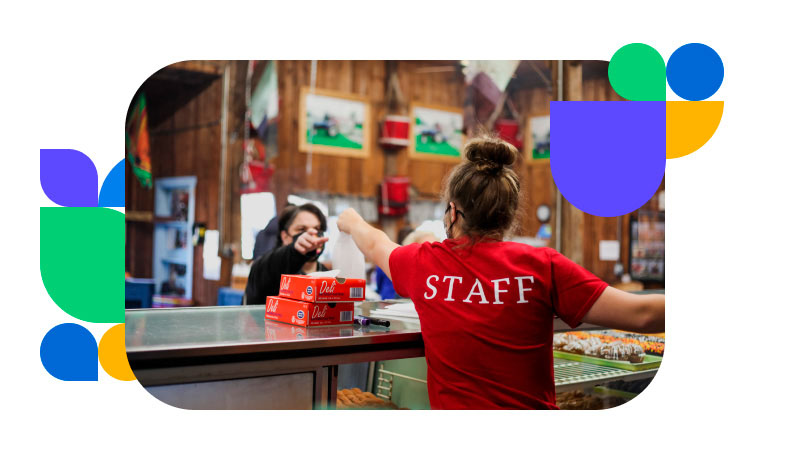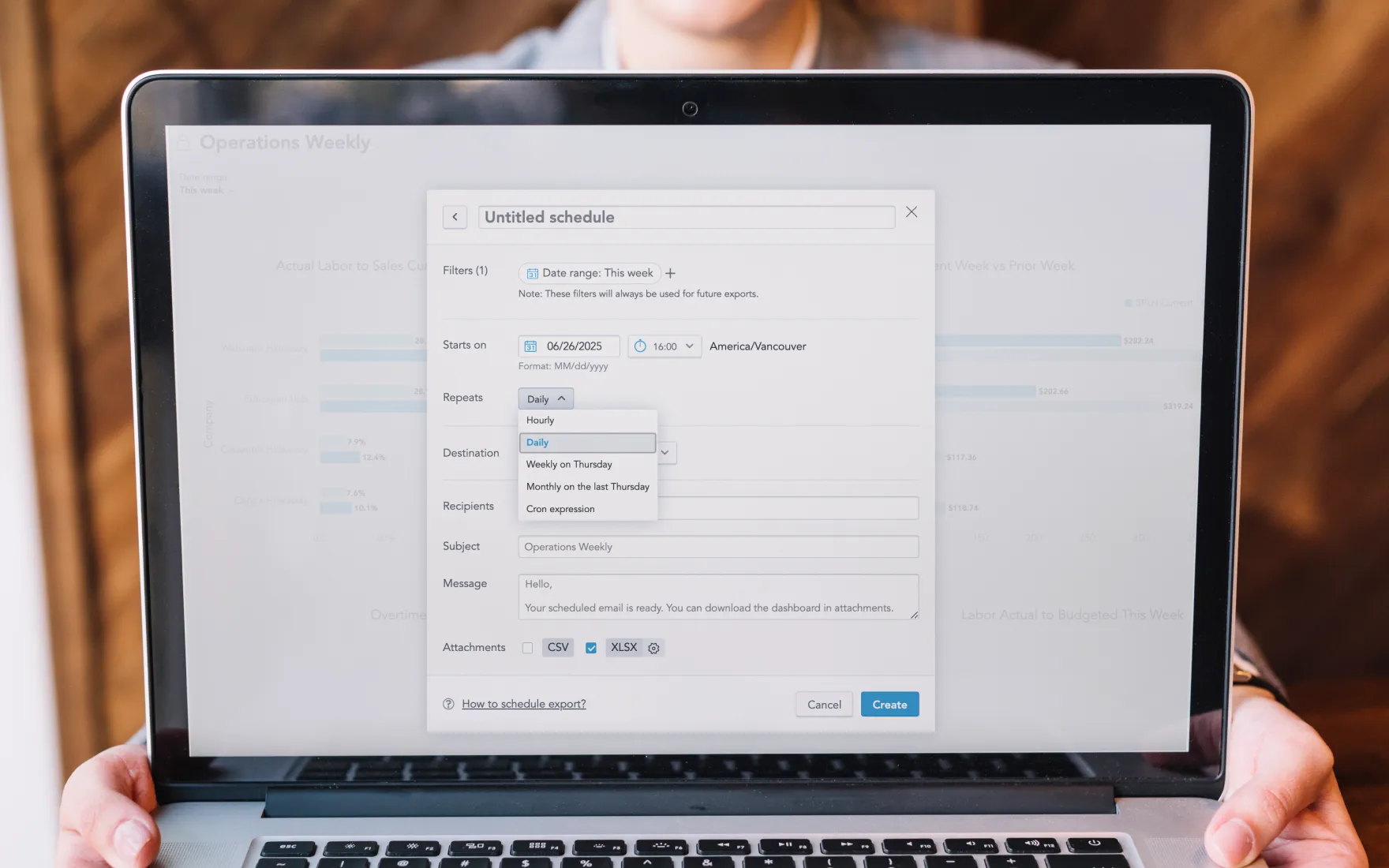7 Ways Employee Onboarding Software Helps Restaurants Thrive

What is employee onboarding software, and why does it matter? This article will explore the top reasons why adding these tools to your business could save you big time. Starting with the biggest reason, employee turnover.
The first month and a half account for 20% of employee layoffs. While testing the waters, employees have the time to get a feel for your restaurant. To improve the process, you should invest in employee onboarding software.
What is employee onboarding software?
Employee onboarding software provides tools for business owners to gather important information from new hires and store it online.
This software typically helps with gathering and storing important employee documents, making it easier for new employees to integrate with your business. It can also help with digitizing important documents so business owners no longer have to deal with paperwork.
As a restaurant owner, your business needs employees to get up to speed quickly. A fast-paced environment demands engaged people, so it's important that this software helps move things along efficiently.
Employee onboarding software is usually part of an entire HR suite of tools. These tools typically include the following features:
- Applicant tracking software (recruiting tools)
- Onboarding tools
- Interview tools
- Employee retention tools
- Time tracking software
- EWA (early wage access offerings)
If you are lucky, you will also find payroll handling tools that also integrate with the software -however, these are less common, but highly recommended.Still undecided about employee onboarding software? Below are some compelling reasons to buy in.

1- Employee onboarding software helps keep great hires.
Restaurant turnover rates after the Big Quit have skyrocketed. Turnover rates currently sit at about 75%. That means owners can expect three out of four hires to leave.
Short-sighted owners fail to realize this as a problem. Many will rely on the remaining staff, overburdening them as a result and leading to yet more turnover.
So how does onboarding software help? It gives you (the owner) an opportunity to set proper expectations. A detailed job listing helps, but further details are provided throughout the onboarding process.
An onboarding process clarifies these areas of importance for new hires:
- What benefits you provide
- Clarification on your company policy
- Initial pay information
- Duties and expectations
- Confirmation of performance standards
- Your structure for improving wages
Restaurants with weak onboarding systems crush their employees from Day One. Many great hires are plopped in front of training videos and moved into their first position without proper explanation.
Ambitious and hard-working individuals, they will ask probing questions. Without a resource to confirm this information, disillusioned workers will eventually leave.
Your onboarding process should work as the inspiration that keeps them around. Show your strategy and a clear structure that works from an employee-first perspective. Work towards things that appeal to them.
More money, benefits, and respect are uncommon among entry-level restaurant positions. Through your onboarding process, you can share some of your passion as a restauranteur. You will inspire them to pursue those better positions by setting a clear pathway.
2 - It helps business owners stay compliant.
Non-compliance is a general term that applies to not following the rules. Your version of the regulations refers to following local, state, and federal guidelines as a business owner. Restaurants also need to meet the needs of food safety inspectors.
The most common reasons a restaurant fails inspections are:
- Improper food storage and handling
- Failing to implement cross-contamination safeguards
- Not cleaning the restaurant properly
At best, a food safety failure gives you a warning. You will also often get a notice pinned to the restaurant identifying your negligence. That notice informs potential customers of your non-compliance. Everyone entering will have second thoughts about going to your place of business.
A big part of employee onboarding software is conveying the importance of compliance to your employees. Training systems include acknowledgments of understanding in this process, making it easier to hold your employees accountable.
This enables you to send them back for retraining on the process where necessary. You might also perform an internal investigation. Because onboarding typically comes with employee performance tracking, you can also note management’s concerns about particular employees.
A great, dedicated human resources platform offers better accountability. Through that accountability, you create a system of checks and balances. This empowers your employees to identify poor management while management identifies troubled employees.
Trusted managers should be able to take criticism. Doing so is a sign of leadership, a necessary skill for building amazing restaurants.

3 - You can hire more great people, faster.
40% of restaurant owners struggle with their onboarding process lasting for more than a month. Faster processing enables you to hire great employees at a faster rate—a powerful tool in an industry with a naturally high turnover rate.
Standard onboarding processes are inconsistent as far as timing is concerned. This inconsistency is because it is difficult for each manager to track when employees reach specific milestones. Therefore, onboarding completion comes from a leader’s perspective.
While good leaders provide excellent insight, you are ultimately the process maker. Employee onboarding software allows you to establish this process with ease.
Here’s how:
- Good software enables you to develop a set of milestones based on your training experience.
- You can better show scalability when expanding into new buildings.
- It provides people with a convenient way to check restaurant protocol (no looking through dense policy books).
- It allows you to create a more engaging training experience.
- When training, an exemplary process makes it easier to identify people who have potential (those who pursue further milestones beyond training).
When an onboarding process doesn’t extend beyond a month, it enables an employee to pursue more lofty goals. Becoming a department head or manager is attainable in those cases. It also provides you with existing experts you can use to staff new restaurants.
Onboarding is the first step to providing a foundation for employee success. But good onboarding doesn’t drag on for months.
4 - It is part of an integrated HR suite.
An integrated HR provides you with multiple solutions to simplify business processes. Because human resources involve everything to help your people succeed, it’s paramount you get that right. So, integrated HR management software is necessary.
Here’s a list of what you should look for in an integrated solution:
- Hiring and onboarding. Simplify the onboarding process through the use of our employee onboarding software.
- Payroll software. Make tracking hours and paying your employees easy by using our automated payroll software.
- Time tracking. Track the time your employees work using our facial recognition software to make signing in and out a breeze.
- Scheduling. Create schedules easily by using our software to ensure each shift is fully staffed for maximum efficiency.
- Reporting and insights. Find out potential improvements to your business through financial reports and analysis tools.
Integrated HR software works by replacing something that a team of individuals usually handles. Hiring a finance specialist is still a good idea. But you won’t need a team in this case. You can also direct your employees to the automated service if they want pay stubs.
As a business owner, wasting time on these minute issues takes away from your business. This is time you could be spending making strategic decisions. So, if you plan to expand, having an automated system deal with the more menial tasks is critical.

5 - It will help your restaurant save money.
Human error can cost the average-sized restaurant around $30 an order or $9000 every month based on a 5% error rate. It might not sound like much, but it builds up over time. Human error creates a large number of issues:
- Low food-quality standards result in legal issues.
- Kitchen interruptions make everyone wait for food.
- You could be serving new customers in those seats.
- Frustration can cause a kitchen to make further errors.
While you might not lose your restaurant for cooking a steak medium over medium-well, a complaint causes much waste of time. A lot of this stems from kitchen staff who fall back on weaker kitchen procedures from other restaurants.
While this might be understandable when working with line cooks, it demands correction. More experienced chefs (depending on your restaurant) can provide corrects built on your guidance.
Consistency is crucial when it comes to following recipes and processes. Onboarding processes provide the training necessary to learn this recipe. Employee onboarding software can provide consistent access to the recipe for later review.
More experienced chefs can take this access and suggest improvements. Those with years of experience on the front line of the restaurant industry know their stuff. Leveraging their knowledge might make your business better.
From there, you can make corrections to the electronic recipe file. The collaborative focus enables you to pay attention to experts who are masters of their craft. A single chef’s expertise can expand to unlimited restaurants through onboarding software.
6 - It can help your staff become better trained.
Tip number five reminds us of the importance of learning from experienced staff members. However, training is still ultimately up to you as a business owner. Employee onboarding software exists to make this training simpler. Mostly through tracking.
Onboarding tools make it easier for you to determine what stage your employee is at. They provide a consistent means of tracking milestones. All management see these milestones, allowing easy transition as you commence further training.
Onboarding doesn’t only refer to the initial joining of a new hire. It can also refer to a new program. For example, you would have an onboarding process that leads someone from entry-level to expert.
For example, take a look at the McDonald’s system. Moving from crew member to trainer requires completing a checklist. This checklist also comes with testing phases, ensuring employees understand the implications of their new position.
The problem is that McDonald’s is an older business with lax controls. So some disengaged franchise owners will make the mistake of not enforcing the system. The worst-case scenario in management is where unprofessional managers bring their friends into high-ranking positions.
You, being an engaged owner, won’t allow this to happen. The early stages of implementing your training system will require more hands-on work. You’ll want to establish a trusted contact (usually the general manager) to enforce your training.
Onboarding software helps your trusted contact apply consistency to training. Numerous benefits come from fellow staff members and managers who believe in the system.

7 - It saves you time from many questions.
As a business owner, you can waste time on questions. Many of those questions can be addressed by people who work the front line. However, more people are willing to trust the advice of someone who speaks from the top.
It is easy to see why they come to you as the ultimate authority. However, most of those questions are addressable by frontline employees. In some cases, they are better equipped to answer those questions.
Giving your phone number to a few people helps (typically department heads and general managers). However, procedural questions should be left to the system manual. Your HR software dictates what this is.
A big part of employee onboarding should be familiarizing employees with how to find information. More giant corporations hit this wall more often, with procedural questions being hidden by an HR line with a 45-minute wait time. While restaurants are more personal, there is still significant benefit to a self-sufficient employee.
Being able to find this information saves your time for the critical questions. For example, should you consider expanding your restaurant in X city? That question becomes delayed if someone asks you to confirm a training procedure.
To ensure you maintain a strategic focus, employee onboarding software should include a component for research. Providing this information will save you time and empower employees to confirm the accuracy of some statements.
Provide good restaurant onboarding.
When you first introduce a new hire to your restaurant, you need to make it easy. This ease applies to your procedures, growth opportunities, and who handles what. Bringing new staff on gives you an excellent opportunity to integrate incredible employees.
Also, remember that your onboarding shouldn’t exceed a month. At this point, if your new employee isn’t integrated, there is likely some issue with the process. If you notice t this issue recurring, the problem is likely with your onboarding process.
To simplify the process, the usage of employee onboarding software can help. Push Operations provides the best software for complete HR systems. Book a demo today to learn how you can benefit from its use.



